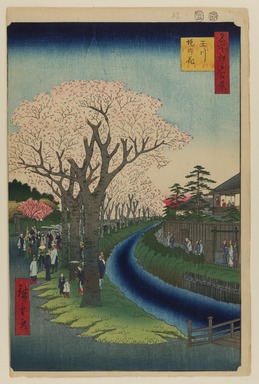
Artist:Utagawa Hiroshige
Medium: Woodblock print
Geograhical Locations:
Dates:2nd month of 1856
Dimensions: 14 5/16 x 9 5/16in. (36.4 x 23.7cm) Image: 14 5/16 x 9 5/16 in. (36.4 x 23.7 cm) Sheet: 12 15/16 x 8 3/4 in. (32.9 x 22.2 cm)
Collections:
Exhibitions:
Accession Number: 30.1478.42
Image: 30.1478.42_PS20.jpg,
Catalogue Description: The Tama River Aqueduct shown here was constructed in 1653-54. It carried drinking water for the city of Edo along a 30-mile course, and continued to carry much of the water supply for the city of Tokyo until the 1960's. Then the old Edo wooden system was replaced with modern equipment and this part of the canal, no longer needed, was paved over. The cherry trees along the embankment were planted in the 1730's and were not only a source of beauty, but helped to keep the water pure through the allegedly antitoxic powers of the leaves and petals. To the left is the entrance to one of the smaller samurai estates. In the Edo period, most of this park was the estate of the Naito clan, lords of Takata; subsequently, it served as an agricultural college, a private imperial garden and since 1949 as a public park. The two-story buildings mark the Naito Shinjuku settlement, where one can see a customer and three "serving girls" as they were known, in the rear quarters of a brothel to the right of the canal.